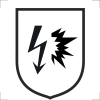Live working – The protective clothing against thermal hazards of an electric arc
EN 61482-2 - LIVE WORKING – PROTECTIVE CLOTHING AGAINST THERMAL HAZARDS OF AN ELECTRIC ARC
Materials and garments tested according to EN 61482-2 are evaluated for their protection against the extreme heat generated in an arc accident. The standard establishes the level of protection required to prevent second-degree burns, using the Stoll curve* as the basis for this evaluation. The protection comes from the garment’s flame resistant properties and its ability to absorb heat energy, discharged at an arc, measured in cal/cm². The higher the absorption of the material or material combination, the better the protection. Other hazards of an electric arc, which the standard does not include, are molten metal splashes, pressure waves, electric shocks and hazardous gases created when a fabric is vaporized.
Wearing multiple layers of arc-certified garments increases protection in case of an accident. In addition to each layer providing protection on its own, it is primarily the air gap between each layer that serves as the main barrier against heat energy. Blåkläder recommends a three-layer concept with an outer layer, a middle layer, and, closest to the body, a flame-resistant base layer to maximize protection against heat and reduce the risk of burns.
It is not possible to theoretically calculate the expected level of protection that a clothing concept provides; instead, each unique material combination must be tested to obtain a relevant value. This is because, even if the performance of each individual material is known, it is not possible to predict the effect of the air gaps between the layers. It is crucial how smooth, uneven, flexible, or stiff each material is and how they interact with one another.
*) Stoll curve; The relationship between thermal energy and
time that is the limit of second degree burn.
EN IEC 61482-1-1 (test method)
Open arc test: in this test, material and garments are exposed to an open electric arc. Each material or material combination receives a result expressed in cal/cm² (calorific value). This value represents the threshold of thermal energy a material can be exposed to while still providing protection against second-degree burns.
ATPV-Value (Arc Thermal Performance Value) indicates the amount of energy (cal/cm²) the material/garment can be exposed to while still providing a 50% level of protection against second-degree burns.
EBT-Value (Energy Break Open Threshold) indicates the amount of energy (cal/cm²) indicates the amount of energy (cal/cm²) the material/garment can be exposed to before there is a 50% risk of fabric breakopen.
ELIM-Value (Incident Energy limit). As a complement to the ATPV and EBT values, an additional level called ELIM (Incident Energy Limit) has been introduced for Open Arc testing. ELIM is the upper limit of thermal energy that a material/garment can be exposed to without posing a risk of second-degree burns to the wearer or causing breakopen in the fabric. For ATPV and EBT, there is always a (50%) risk that a second-degree burn or fabric breakopen may occur.
EN 61482-1-2 (test method)
Box test:In this test method, materials and garments are exposed to an electric arc confined in a box at a specific value. The arc current is 400 V and the duration is 500 ms. The test is performed in two different classes. The test result is either pass or fail. To meet APC 2 requirements, combinations of different garments or insulated (lined) garments are often necessary.
| APC (Arc Protection Class) | Electrical arc [kA] | Time [ms] |
|---|---|---|
| 1 | 4 | 500 |
| 2 | 7 | 500 |
Reference to NFPA 70E
HRC categories; Hazard Risk Category derived from the US Standard of Electrical Safety NFPA 70E. Sometimes this categorization is also used for risk assessment in Europe.
HRC 1: 4-8 cal/cm²
HRC 2: 8-25 cal/cm²
HRC 3: 25-40 cal/cm²
HRC 4: >40 cal/cm²
The HRC categories are now referred to as Arc Flash PPE Category.

License for using the standard
This text is an interpretation of the content in the Standard concerned, reproduced with the requisite authorization for Blåkläder from the Swedish Institute for Standards, which is the owner and copyright holder of the Standard and also sells the complete Standard at www.sis.se
